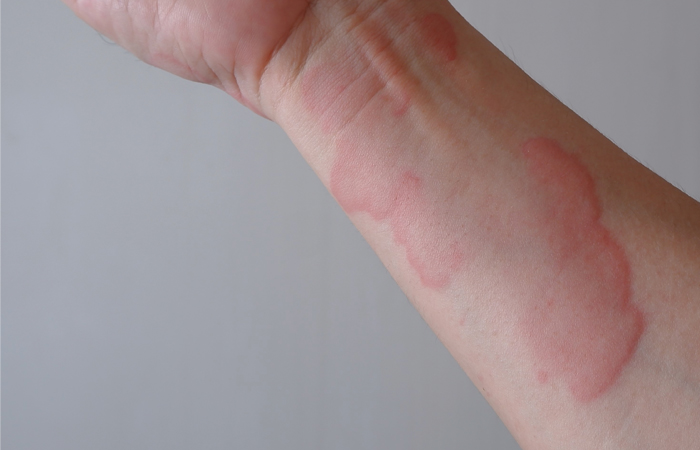In OTC
Follow this topic
Bookmark
Record learning outcomes
Around 21 million people, a third of the UK population, are said to be living with allergies, according to Allergy UK. Persistent allergy symptoms – whether from house dust mite allergies, atopic eczema, allergic asthma or food allergies – can interfere with sleep, affect concentration, disrupt education or employment and significantly reduce quality of life. For people living with food allergies, social activities can also be a challenge, affecting their mental health.
In August 2025, Allergy UK launched a campaign to improve allergy awareness, encourage early diagnosis and enable patients to access the support they need.
The charity’s ‘I Wish I Knew…’ campaign’s three key messages are: that allergies can develop at any age, that allergies can exacerbate other health conditions such as asthma, and that getting an allergy diagnosis is crucial as it’s the key to accessing the right care and support.
Allergy UK is encouraging healthcare professionals, including community pharmacy teams, to join their ‘I Wish I Knew…’ campaign.
This involves directing patients to trusted information about common allergies (such as the Allergy UK website), and giving patients practical advice on managing their symptoms, not only by taking medicines but also with avoidance strategies and self-help measures.
House dust mites
House dust mite allergy is very common – estimated to affect around 13,000 people in the UK. Although these tiny insects live in homes all year round, house dust mite levels tend to rise with indoor heating and poor ventilation, which is why the allergy is usually worse during the autumn and winter months.
Measures to reduce house dust mite exposure include a thorough and regular cleaning regime at home, but most exposure occurs in bed, which means avoidance is difficult.
“The most common symptoms of house dust mite allergy is a blocked nose and sniffling,” says Dr José Costa, senior allergy consultant at thechildrensallergy.co.uk.
“If sufferers tend to breathe through their mouths or snore, symptoms can also include a dry mouth and, as symptoms progress, this can lead to allergic asthma, which often can become perennial (constant) asthma.”
Other common symptoms can include an itchy nose, eyes or throat, postnasal drip, itchy skin and a tight chest. These symptoms may be worse at night, affecting sleep, or on waking – which then affects concentration during the day.
Treatments for house dust mite allergy, either over-the-counter from pharmacies or on prescription, include corticosteroid nasal sprays, saline nasal sprays or rinses, and non-sedating antihistamines such as cetirizine. It’s important to use these treatments every day.
An allergen barrier balm (or petroleum jelly) around the edge of each nostril may help to trap allergens. If someone has a cough or asthma, a GP may prescribe an inhaler.
All of these treatments may help to ease the symptoms but don’t address the underlying cause – the house dust mite allergy itself. Immunotherapy (desensitisation) is available for people aged 12-65 with severe house dust mite allergy symptoms – privately and through some NHS hospitals.
The immune system is gradually exposed to small, controlled doses of house dust mite allergens through a tablet under the tongue. Over time, it reacts less strongly to the mites, which in turn reduces the allergy symptoms.

“Cashew nuts are now the leading cause of nut anaphylaxis in children”
Food allergies
Food allergies are often associated with childhood, but research in the British Medical Journal in 2024 found that around 50 per cent of adults with food allergies developed their allergy when they were over the age of 35.
The 14 most common food allergens in the UK (which must be listed on food labels) are celery, cereals containing gluten (wheat, rye, barley, oats), crustaceans, eggs, fish, lupin, milk, molluscs, mustard, peanuts, sesame, soybeans, sulphur dioxide and sulphites (over 10ppm), and tree nuts.
However, as people’s diets and lifestyles have changed in recent years, the most common food allergens seem to be changing too.
According to Allergy UK, the rise in plant-based diets has led more people to develop allergies to legumes and pea proteins (such as garden peas and mange tout).
Anaphylaxis UK highlighted in August 2025 that serious allergic reactions are also occurring from other foods, such as goat’s and sheep’s milk and cheese, buckwheat, lentils, pine nuts, kiwi, apples and beehive products.
Peanuts and tree nuts (such as hazelnuts, almonds, walnuts and pecans) are among the most common food triggers for severe allergic reactions.
However, a research study using data from the European Anaphylaxis Registry published in June 2025, found that across Europe, cashew nuts are now the leading cause of nut anaphylaxis in children, and almonds are an unexpected risk for adults.
Mild to moderate allergy symptoms should be treated with antihistamine tablets as soon as possible. If the symptoms are affecting the airways (e.g. throat tightness or difficulty swallowing), breathing (including wheezing and chest tightness) and/or circulation (e.g. feeling dizzy or faint), this is a severe allergic reaction (anaphylaxis).
It’s important to administer adrenaline immediately (see anaphylaxis boxout). Antihistamines shouldn’t be taken instead of adrenaline if an allergic reaction is severe.
Two adrenaline auto-injector devices should be prescribed by a GP or allergy consultant to anyone who is at risk of a severe allergic reaction. The devices should be injected into the muscle in the middle of the outer thigh (upper leg).
These are designed to be easy to use, but different brands have slightly different instructions, so it’s important that patients (and their families, friends and carers – including teachers) know how to use them.
The devices must be replaced when out-of-date and must be stored properly as adrenaline is sensitive to light and can be damaged by high or low temperatures.
“Pharmacy teams should advise customers to carry two autoinjectors with them at all times, that have not expired, along with non-sedating antihistamines such as cetirizine,” says Dr Costa.
“Along with this, they should have an in-date action plan. As these medications need to be kept between 15°C and 25°C, using an insulated bag is always the best choice, not solely for temperature control, but for ease of access in case the medication is needed.”

Anyone with severe allergies should keep two autoinjectors with them and be aware of how to correctly store and administer them.
Allergies versus intolerances
Many people are confused by the terms ‘allergy’ and ‘intolerance’ when it comes to food reactions.
An allergy involves the immune system. On exposure to a particular food, the immune system incorrectly believes that proteins in that food are harmful to the body.
So, the immune system overreacts and launches an inflammatory response, which leads to allergy symptoms such as itching, swelling, difficulty swallowing and breathing problems.
People with a food allergy need to avoid that particular food completely. The symptoms usually occur immediately and can be severe.
An intolerance doesn’t involve the immune system. It occurs when the digestive system finds it difficult to digest a particular food, such as lactose in milk or fruit sugar.
Some people with an intolerance can manage to eat small amounts of that food or in certain formats (such as yoghurt but not plain cow’s milk).
The symptoms can occur several hours after eating the food, and include bloating, nausea, diarrhoea and abdominal pain. This can make an intolerance more difficult to identify.
Food allergies can usually be diagnosed with blood tests or skin prick testing. Food intolerances are more challenging to diagnose – other than for lactose intolerance, there are no specific tests.
An exclusion diet can help, but needs to be done under the guidance of a dietitian or specialist doctor.
“50 per cent of adults with food allergies developed their allergy when they were over the age of 35”
Animal allergies
Most people with an animal allergy are allergic to cats and dogs, but allergies can also occur to other animals, including rodents, rabbits, horses and even birds.
Animal fur itself doesn’t trigger the allergy – affected people are allergic to proteins in pet dander (dead skin cells), saliva, urine, faeces, sweat or skin oils.
Certain breeds may not provoke an allergic reaction or may only cause mild symptoms, but this is impossible to predict. Some people can have a cat allergy despite never having lived with one.
Most pet allergy symptoms occur straight away, such as sneezing, nasal congestion and a tight chest. These symptoms can often be eased with antihistamine tablets and/or corticosteroid nasal sprays.
Some people develop swollen, itchy eyes (allergic conjunctivitis) or a rash on their skin (hives or eczema). Others may have asthma symptoms – acute wheezing, cough and shortness of breath – especially children.
Avoiding animals is the best way to prevent pet allergy symptoms, but this isn’t always possible. It’s important to wipe down, groom and bathe pets regularly to remove dander and saliva, as well as vacuuming the car, soft furnishings and carpet.
Pets should be kept out of the bedroom – using a HEPA air purifier can help to remove as many pet allergens as possible. Washing hands with soap and water after touching an animal is important – and for general hygiene, too.

Insect bites and stings
Most allergic reactions to insect bites and stings are mild, causing localised itching, pain, redness and swelling at the bite or sting site. But some people have a severe insect allergy that triggers life-threatening anaphylaxis.
Smaller reactions will often ease after a few days on their own or after taking antihistamine tablets. If the allergy symptoms persist, or the redness and swelling is spreading, it’s important to get the bite or sting assessed.
This could be caused by a worsening allergic reaction or be a sign of an infection (insect bites can be assessed through the Pharmacy First pathway).
If people are prone to anaphylaxis, they should always carry an adrenaline autoinjector to use without delay. If someone is stung on the face or neck and the swelling goes to their tongue, throat or airways, or they are experiencing difficulty breathing, are choking, fainting or collapse, it’s important to call 999 for emergency medical help.
Immunotherapy (desensitisation) is available on the NHS for people with severe allergic reactions to wasp or bee venom. The treatment involves weekly injections for 12-15 weeks in a specialist allergy clinic, then ‘maintenance doses’ of venom are given every six to eight weeks for three to five years.
Avoiding insect bites and stings involves taking certain precautions, such as always wearing shoes or sandals outside, avoiding wearing strong perfumes and other scented products, wearing long sleeves and trousers, especially in the evenings, covering up food and drinks outdoors, avoiding rubbish bins, and keeping calm around wasps and bees, especially if they land on your skin (although the natural instinct is to wave your arms and panic).
“Allergic reactions to insect stings are fairly common,” says Dr Costa. “The people at higher risk tend to be the ones who deal with insects more often, such as beekeepers, gardeners and pest-control workers. The main risk factor is having several stings or bites.”
Medicine allergies
All medicines can cause side-effects but most people experience none or very few. Common side effects such as nausea, diarrhoea, itching or rashes are often mistaken for an allergic reaction, so it can be difficult to establish the exact cause. The only way to know for sure is to have specialist allergy testing.
According to the European Academy of Allergy and Clinical Immunology (EAACI), 90 per cent of people who have been told that they are allergic to antibiotics, such as penicillin, don’t have a true allergy when they are properly tested.
Being labelled falsely as allergic to antibiotics could mean people are missing out on the best treatment options for infections.
“The allergic reactions that are likely to be almost immediate tend to be where the medication has been given intravenously,” says Dr Costa.
“For oral medication, the variability is great, with some cases of people developing a reaction after the treatment has ended. As such, it is often difficult to decide if a reaction has truly been to a medication or not.”
Genuine drug allergy can involve penicillin, some anesthetics and vaccines. If someone has a severe reaction to a particular drug, or a repeated reaction on several occasions, this will be recorded in their medical notes.
If people are severely allergic to a specific medicine, they should consider wearing allergy alert jewellery to make sure they are not given that medicine again.
Anaphylaxis attacks
If someone is experiencing a severe allergic reaction (anaphylactic attack), they need adrenaline immediately. If they are carrying an adrenaline autoinjector, it’s important to use this without any delay. It’s also important to call for an ambulance (via 999), explaining that they are having an anaphylactic attack.
Lie the person flat – or sit them up slightly if this position affects their breathing. Don’t stand them up or move them (as long as they are in a safe place) and stay with them until medical help arrives.
If the patient’s symptoms aren’t getting better after five minutes, use a second dose of adrenaline into their other leg (if another adrenaline autoinjector is available).
Even if they seem well after the adrenaline, they should always go to hospital for further assessment and treatment.

